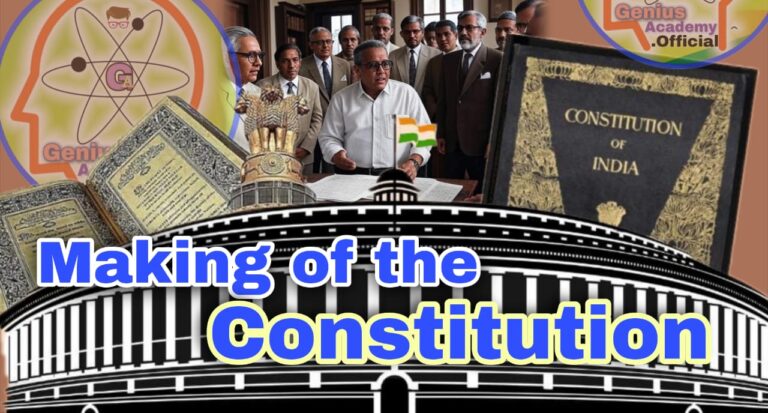India’s Growing Influence in Global Innovation
Introduction
India has emerged as a pivotal player in the global innovation landscape, driven by robust policies, increasing domestic capabilities, and significant international recognition. The World Intellectual Property Organization (WIPO) recently released its World Intellectual Property Indicators (WIPI) Report 2024, which underscores India’s remarkable achievements in intellectual property (IP) filings. This development coincides with India’s improved position in the Global Innovation Index (GII) 2024, reflecting its commitment to fostering innovation. This detailed analysis explores India’s performance in IP filings, its innovation ecosystem, and the challenges and opportunities ahead.

The WIPI Report 2024: A Global Perspective
Global Growth in IP Filings
The WIPI Report 2024 highlights a global growth in intellectual property activities:
- Patent Applications:— Globally, 3.55 million patent applications were filed in 2023, marking a 2.7% increase from 2022. This growth was largely driven by key economies, including China, the United States, Japan, South Korea, and India.
- Innovation Contributions:— The report reflects the strategic emphasis on innovation among leading economies, with India standing out as a key contributor.
India’s Performance in Intellectual Property Filings
Patents
India achieved a remarkable milestone in 2023, registering a 15.7% growth in patent applications, the highest among the top 20 global origins. Key statistics include:
- Ranking:— India now ranks 6th globally in patent filings, with 64,480 applications.
- Resident Filings:— For the first time, over 55.2% of patent applications were filed by Indian residents, showcasing growing domestic innovation capabilities.
- *Patent Grants:— The number of patents granted in India surged by 149.4% compared to the previous year, reflecting an increasingly supportive IP ecosystem.
Trademarks
India displayed strong performance in trademark filings:
- Ranking:— India secured the 4th position globally in trademark applications, with a 6.1% increase in 2023.
- Domestic Focus:— Nearly 90% of trademark filings were by Indian residents, signifying the rise of domestic brands and enterprises.
Industrial Designs
India achieved a notable 36.4% growth in industrial design applications:
- Sectoral Contributions:— Key sectors driving this growth include textiles, tools, and healthcare.
- Creative Economy:— The rise in industrial designs reflects India’s growing influence in creative industries.
India’s Leap in the Global Innovation Index 2024
Improved Ranking
India achieved a significant milestone in the Global Innovation Index (GII) 2024:
- Rank:— India secured the 39th position among 133 economies, a dramatic improvement from 81st in 2015.
- Sectoral Strengths:— The ranking underscores India’s focus on innovation outputs, policies, and industry-academia collaboration.
Science and Technology (S&T) Cluster Recognition
India ranked 4th in WIPO’s Science & Technology (S&T) Cluster Ranking, with major cities like Mumbai, Delhi, Bengaluru, and Chennai featuring among the world’s top 100 clusters.
Innovation Outputs
India’s innovation outputs have significantly improved:
- Global Ranking:— India now ranks 33rd globally in innovation outputs.
- Intangible Assets:— The country is ranked 7th globally in intangible asset intensity, demonstrating strong intellectual capital.
Economic Impacts of Innovation
India’s rise in innovation rankings has tangible economic implications:
- Job Creation:— Increased innovation activity has led to the creation of high-skilled jobs across sectors.
- Enhanced Productivity:— Innovation-driven growth has improved productivity in industries ranging from technology to manufacturing.
- Economic Development:— Innovation contributes significantly to India’s GDP, reflecting a positive correlation between innovation and economic expansion.
India’s Intellectual Property Rights (IPR) Framework
Policy Initiatives
India has implemented several initiatives to strengthen its IPR ecosystem:
- National IPR Policy:— Launched to streamline and strengthen the IPR framework, fostering a culture of innovation and creativity.
- National Intellectual Property Awareness Mission (NIPAM):— Aims to increase awareness of IPR among schools, colleges, and businesses.
- Atal Innovation Mission:— Supports startups and entrepreneurs through innovation hubs.
- Startup India and Atmanirbhar Bharat Campaigns:— Encourage domestic innovation and self-reliance.
Institutional Support
- Technology Innovation Support Centres (TISC):— Established in universities to assist with IP filings and commercialization.
- SPRIHA Scheme:— Introduced to integrate IPR education into higher learning institutions and establish IPR Chairs in academic institutions.
Economic Correlation
The growing number of IP filings in India has positively influenced the patent-to-GDP ratio, reflecting that IP activity scales alongside economic development.
Challenges in India’s IPR Regime
Despite its achievements, India’s IPR system faces several challenges:
Patent Backlog and Processing Delays
- Issue:— India’s backlog of patent applications delays innovation and may discourage inventors.
- Impact:— Long processing times can hinder the timely protection of innovations.
Enforcement Issues
- Challenge:— Enforcement of IPR laws remains inconsistent, leading to piracy and counterfeiting.
- Solution:— Strengthening ground-level enforcement mechanisms is essential.
Awareness and Accessibility
- Problem:— Many creators and businesses, especially small and medium enterprises (SMEs), lack awareness of IP protection mechanisms.
- Opportunity:— Increasing awareness campaigns can bridge this gap.
Balancing Public Access
- Concern:— Ensuring public access to essential goods, like medicines, while protecting IP rights remains a delicate balance.
- Way Forward:— Developing policies that align innovation with public welfare is critical.
Infrastructure and Resources
- Issue:— Limited resources and outdated infrastructure hinder the efficient administration of IPR.
- Need:— Investing in modern IP offices and training personnel can address this bottleneck.
Government Strategies to Overcome Challenges
To address these challenges, the Indian government has launched multiple initiatives:
- Modernization of IP Offices:— Upgrading technology and infrastructure for faster processing of applications.
- Strengthening Enforcement Mechanisms:— Training enforcement agencies to tackle issues like counterfeiting and piracy effectively.
- Public Awareness Campaigns:— Educating businesses and the public on the importance of IPR.
- Global Alignment:— Aligning domestic IPR policies with international standards and treaties.
Conclusion and Way Forward
India’s growing influence in global innovation, as highlighted in the WIPI Report 2024 and the GII 2024, reflects a strong commitment to fostering creativity, research, and development. The country’s remarkable performance in patents, trademarks, and industrial designs demonstrates its ability to compete on a global scale. However, to sustain this momentum, India must address critical challenges in its IPR regime, including backlog issues, enforcement inconsistencies, and public awareness gaps.
Recommendations
- Enhancing Infrastructure:— Modernizing IP offices and training personnel.
- Policy Updates:— Aligning IPR policies with global best practices to remain competitive.
- Education and Awareness:— Promoting IPR education at grassroots levels to build a culture of innovation.
- Strengthening Enforcement:— Ensuring effective implementation of IPR laws to protect creators’ rights.
Daily Mains Practice Questions
UPSC (CSE) Mains Questions on India’s Growing Influence in Global Innovation
GS Paper II: Governance, Constitution, Polity, Social Justice, and International Relations
| [Q1.] “India’s IPR framework has shown significant progress, but enforcement and infrastructure issues still persist.” Discuss in the context of India’s performance in global innovation rankings. (250 words) |
| [Q2.] Critically analyze the role of government initiatives such as Atal Innovation Mission and National IPR Policy in fostering innovation and creativity in India. (250 words) |
| [Q3.] “The balance between protecting intellectual property and ensuring public access to essential goods like medicines remains a challenge.” Examine the relevance of this statement in the context of India’s innovation ecosystem. (250 words) |
GS Paper III: Economic Development, Science & Technology, and Environment
| [Q4.] Examine the significance of India’s improved ranking in the Global Innovation Index 2024 and its implications for economic development and job creation. (250 words) |
| [Q5.] India has shown remarkable growth in patent filings, industrial designs, and trademarks. How does this reflect the country’s domestic innovation capabilities and sectoral growth? (250 words) |
| [Q6.] Discuss the challenges faced by India’s intellectual property rights regime, such as patent backlogs, enforcement inconsistencies, and public awareness, and suggest measures to address them. (250 words) |
| [Q7.] “The rise in India’s patent-to-GDP ratio indicates a direct correlation between IP activity and economic growth.” Analyze this statement with examples. (250 words) |
Frequently Asked Questions (FAQs) on India’s Growing Influence in Global Innovation :
1. What is the significance of the WIPI Report 2024 for India?
Answer:—
The WIPI Report 2024 highlights India’s remarkable growth in intellectual property filings, including patents, trademarks, and industrial designs. India achieved the highest growth rate among the top 20 global economies, ranking 6th in patent filings and 4th in trademark filings. This reflects India’s growing domestic innovation capabilities and its emergence as a key global innovator.
2. How has India performed in the Global Innovation Index 2024?
Answer:—
India secured the 39th position in the Global Innovation Index 2024, a significant improvement from 81st in 2015. This ranking reflects India’s robust policies, increased research and development (R&D) investment, and innovation-friendly environment. It also highlights India’s achievements in intangible assets and its prominent S&T clusters.
3. What are the key challenges in India’s IPR framework?
Answer:—
Key challenges include:
- Patent Backlog: Delays in processing patent applications discourage innovation.
- Enforcement Issues: Inconsistent implementation of IPR laws leads to piracy and counterfeiting.
- Public Awareness: Limited knowledge about IP protection mechanisms among creators and businesses.
- Infrastructure Deficiencies: Outdated systems and limited resources hinder the efficient administration of IPR.
4. What government initiatives support India’s IPR ecosystem?
Answer:—
The government has launched several initiatives, including:
- National IPR Policy: Streamlining the IPR framework.
- NIPAM: Promoting awareness of intellectual property.
- Atal Innovation Mission and Startup India: Encouraging entrepreneurship and innovation.
- SPRIHA Scheme: Integrating IPR education into higher education.
- TISCs: Supporting IP filings and commercialization.
5. Why is India’s innovation ecosystem important for its economic growth?
Answer:—
India’s innovation ecosystem drives economic development through:
- Job Creation: Generating high-skilled employment opportunities.
- Productivity Gains: Enhancing industrial efficiency and competitiveness.
- Global Recognition: Attracting investments and collaborations.
- Patent-to-GDP Ratio: Indicating that IP activity scales with economic growth.
6. How can India improve its IPR framework?
Answer:—
India can improve its IPR framework by:
- Modernizing Infrastructure: Upgrading technology in IP offices.
- Streamlining Processes: Reducing patent application backlogs.
- Strengthening Enforcement: Training personnel to combat counterfeiting and piracy.
- Increasing Awareness: Educating SMEs and individuals about IP protection.
- Policy Alignment: Updating laws to match international standards.
7. What does India’s growth in patent filings signify?
Answer:—
India’s 15.7% growth in patent filings in 2023, the highest among the top 20 global economies, indicates:
- Increased domestic innovation capabilities.
- Stronger research output from Indian institutions and industries.
- A supportive policy environment for innovators and startups.
8. How has India performed in trademark and industrial design filings?
Answer:—
- Trademarks: India ranked 4th globally in 2023, with nearly 90% of filings by residents, highlighting the rise of Indian brands and domestic enterprises.
- Industrial Designs: A 36.4% increase was observed, driven by sectors like textiles, tools, and healthcare, reflecting India’s growth in creative industries.
9. What role does the government’s National IPR Policy play?
Answer:—
The National IPR Policy aims to:
- Promote awareness of intellectual property rights.
- Simplify IP processes to encourage filings.
- Strengthen enforcement to protect inventors.
- Align India’s IPR framework with international standards.
This policy underpins India’s rapid advancements in IP-related metrics.
10. What are Technology Innovation Support Centres (TISC), and how do they help?
Answer:—
TISCs are centers established in universities and institutions to:
- Assist with patent applications and filings.
- Support commercialization of IP.
- Provide access to technological information and training for innovators.
11. What is the significance of India’s ranking in the Science & Technology (S&T) Cluster Rankings?
Answer:—
India ranks 4th in WIPO’s S&T Cluster Rankings, with cities like Bengaluru, Mumbai, Delhi, and Chennai listed among the world’s top 100 clusters. This highlights:
- Strong research output.
- A growing ecosystem of startups and innovation hubs.
- Contributions to global advancements in technology and science.
12. How does the rise in patent-to-GDP ratio reflect India’s growth?
Answer:—
The increase in India’s patent-to-GDP ratio signifies that innovation and IP filings are scaling with economic growth. It shows that research, development, and creativity are contributing significantly to India’s economic progress.
13. What sectors are driving India’s intellectual property filings?
Answer:—
Key sectors contributing to India’s IP growth include:
- Health and Agriculture: Dominant in trademarks.
- Textiles and Tools: Prominent in industrial designs.
These sectors indicate innovation in both traditional and emerging industries.
14. How has India integrated IPR education into its academic system?
Answer:—
The government’s SPRIHA Scheme integrates IPR education by:
- Establishing IPR Chairs in universities.
- Facilitating research, teaching, and training in IP.
- Encouraging students and researchers to file patents and protect their innovations.
15. What are the major challenges in enforcing India’s IPR laws?
Answer:—
Challenges include:
- Inconsistent implementation of laws.
- Weak enforcement at the local level, leading to piracy and counterfeiting.
- Limited capacity of enforcement agencies to address IPR-related violations.
16. What steps can India take to improve awareness of IPR?
Answer:—
- Launch more targeted campaigns for SMEs, startups, and innovators.
- Incorporate IP education into school and college curricula.
- Provide training workshops and online resources for businesses and individuals.
17. Why is balancing public access and IPR protection important in India?
Answer:—
Striking a balance ensures:
- Innovators receive fair incentives for their creations.
- Public access to essential goods, such as medicines and agricultural innovations, is not compromised.
This is especially crucial for a country with diverse socio-economic needs.
18. How can India align its IPR policies with global standards?
Answer:—
India can achieve alignment by:
- Participating in more international treaties and agreements.
- Harmonizing its laws with global practices, especially in emerging areas like artificial intelligence (AI) and biotechnology.
- Strengthening collaboration with global organizations like WIPO.
19. How does India’s innovation ecosystem benefit startups?
Answer:—
India’s innovation ecosystem supports startups by:
- Providing funding and mentorship through initiatives like Startup India.
- Simplifying patent and trademark processes.
- Encouraging collaboration between academia, industry, and government.
20. What is the role of intangible assets in India’s innovation ranking?
Answer:—
India ranks 7th globally in intangible asset intensity, reflecting:
- A strong intellectual capital base.
- High contributions from software, design, and other knowledge-driven industries.
- The importance of branding and creativity in global markets.
Global Innovation





